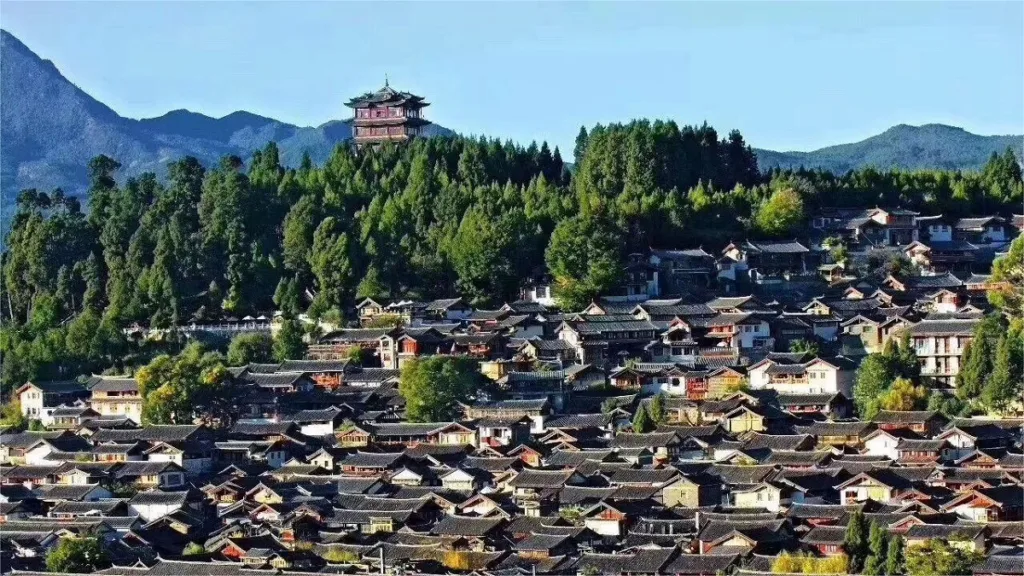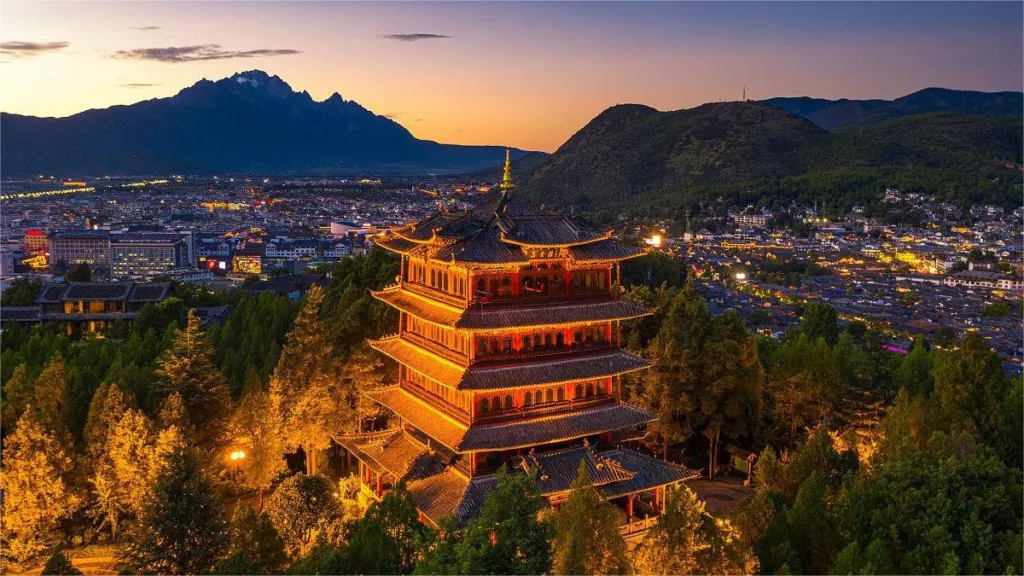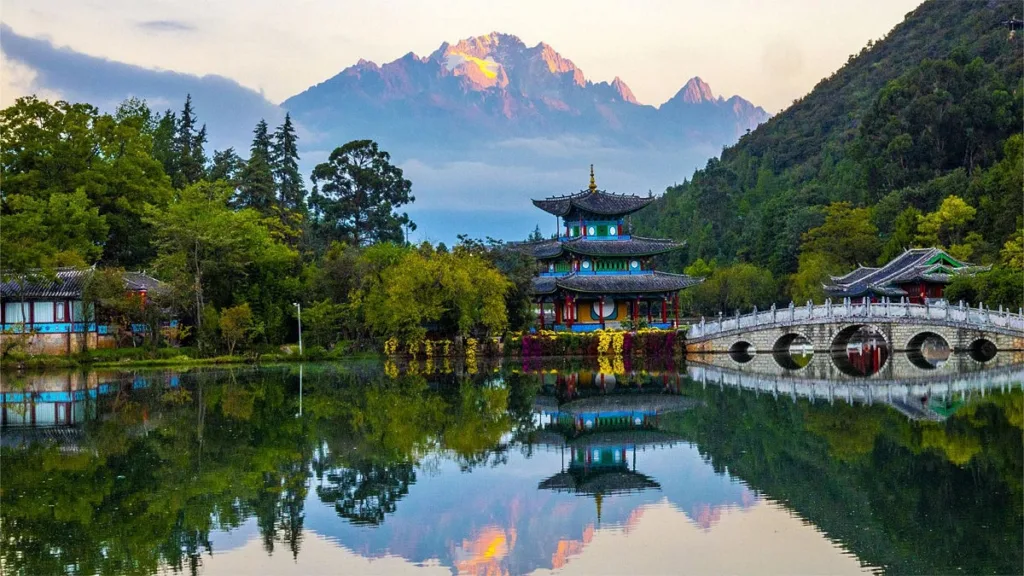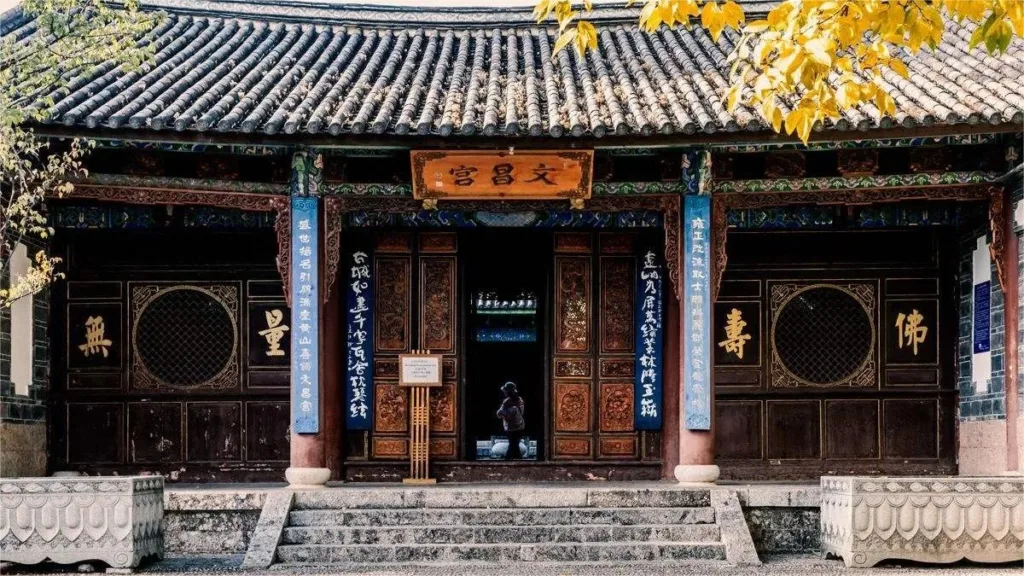Mufu Mansion (木府), also known as the Mu Family’s Mansion and Office, was originally built by Mu De during the Ming Dynasty. It was reconstructed in 1998 and now houses the Lijiang Ancient City Museum. Reflecting the architectural style of the Ming Dynasty in central China, Mufu Mansion also retains the rustic charm of Tang and Song Dynasty buildings, whereas the layout of canals and flowing water within the mansion witnesses the traditional culture of the Naxi ethnic group.
Stretching 369 meters along its central axis from west to east, Mufu Mansion is flanked by Yulong Mountain to the left and Hushan Mountain to the right, with Shizi Mountain behind it and Guishan Mountain to the southeast. Along this axis, there are 15 buildings constructed according to the terrain, including the Zhongyi Arch, Yimen Gate, Former Council Hall, Wanjuan Building, and Hufa Hall, totaling 162 rooms. Inside the mansion, there are eleven plaques bestowed by several generations of emperors, bearing inscriptions such as “忠义 loyalty and righteousness,” “诚心报国sincerely serving the country,” and “辑宁边境 maintaining peace on the border.”
Table of Contents
- Basic Information
- Location and Transportation
- Highlights of Mufu Mansion
- Vlog about Mufu Mansion
- Other Attractions in Old Town of Lijiang
Basic Information
| Estimated Length of Tour | 1 – 2 hours |
| Ticket Price | 40 RMB |
| Opening Hours | 9.00 – 17.30 |
| Telephone Number | 0086-0888-5181468 0086-0888-5122572 |
Location and Transportation
Mufu Mansion is located at 49 Guangyuan Lane, Guanyi Street, Dayan Street, Gucheng District, Lijiang, Yunnan Province. It covers an area of 30,666.66 square meters. To get there, you can take bus 2A, 2B, 3, 4, 7, 10, 11, 14A, 14B, 15A, 15B, 18, 19A, 19B, 24A, 24B, 26, 27, 30, 31, 32, 36, 101, 105, 202, or 209, get off at Zhongyi Market Stop (忠义市场站), and walk about 300 meters to the north to reach the attraction.
Highlights of Mufu Mansion
Zhongyi Arch

Zhongyi Arch, commonly known as the “Stone Archway,” stands proudly in front of Mufu Mansion. It was erected as a symbol of loyalty and righteousness, with the two characters “忠义” bestowed by Emperor Wanli of the Ming Dynasty. Built during the reign of Emperor Qi (1621-1627), the arch reaches a height of over ten meters and is entirely constructed from stone, showcasing exquisite craftsmanship. It is often referred to in local sayings such as “The Three Pagodas Temple in Dali, and the Stone Archway in Lijiang.”
Former Council Hall

The Former Council Hall served as the political center of the Mu Family’s governance. Beneath its eaves hang three plaques inscribed with the phrase “诚心报国” (sincerely serving the country). The central plaque was bestowed by Emperor Zhu Yuanzhang during the Ming Dynasty, the right plaque by Emperor Zhu Di, and the left plaque by Emperor Zhu Houcong. These plaques, bestowed upon the Mu Family by successive Ming emperors, served as reminders of their duty and commitment to serving the nation. In front of the hall lies a vast square paved with colorful stone slabs, where military reviews and receptions for the people were once held. Adjacent to the Former Council Hall is the Hufa Hall, also known as the Rear Council Hall, where family matters and local affairs were discussed.
Wanjuan Building

Wanjuan Building, constructed in the ninth year of the Jiajing reign of the Ming Dynasty (1530), serves as a testament to the Mu Family’s reverence for Han culture. The Mu Family cherished literature, believing in “knowing poetry and books, and embracing courtesy and righteousness.” The building houses a vast collection of classical Chinese texts, including histories, classics, philosophical works, and poetry collections, reflecting over two thousand years of cultural heritage. The collection also includes Buddhist scriptures bestowed by emperors and acquired from Zhejiang Province. Despite the decline of the Mu Family’s influence during the Qing Dynasty, remnants of their literary legacy are preserved within the Wanjuan Building. The current structure was reconstructed in 1999 after the original building fell into disrepair.
Yuyin Building

Yuyin Building, situated in the picturesque garden behind the reservoir, holds significant historical importance as the place where the Mu Family honored the emperor and safeguarded imperial edicts and inscriptions from the Ming to Qing dynasties. The name “Yuyin” phonetically resembles “imperial edict” or “the emperor’s voice.” This architectural gem represents the quintessence of classical Lijiang architecture and symbolizes the Mu Family’s loyalty to the imperial court. The layout of Yuyin Building resembles the Chinese character “亚” (ya), featuring three-tiered eaves and upturned corners. Its grandeur is accentuated by its intricate architectural details, including carved beams, painted rafters, and flying eaves adorned with mythical motifs like phoenixes.








